The Eternal Cuban Non-Conformist Luis Manuel Otero
Samuel Riera talks about Luis Manuel Otero: “an artist in every sense of the word.”

Cuban artist Luis Manuel Otero has been in jail since July 11, 2021. His “crime” is having peacefully and actively opposed laws that infringe on artistic freedom as well as citizens’ civil rights in general.
By the Observatory of Cultural Rights / El Estornudo
HAVANA TIMES – More than a decade ago, Samuel Riera and Luis Manuel Otero Alcántara (LMOA) met. LMOA started attending Riera Studio, a gallery and workshop run by the artist, art professor, and project developer, in the Cerro district. Even then, LMOA had a critical and nonconformist outlook, which began to develop and expand as he connected with people in the Havana art scene, held exhibitions, and intervened in official spaces.
Riera and LMOA established both artistic and friendly bonds, which continued to expand LMOA’s work, particularly concerning community art and its influence on the residents of the most vulnerable and forgotten neighborhoods of the city. Riera Studio, located in Cerro, has been doing commendable work involving neighbors, local school students, self-taught artists, and outsiders, among other collaborators and visitors, contributing to the physical and mental well-being of community members.
Over the years, Riera has tried to preserve some of the work resulting from LMOA’s creative process, make it visible, and place it in the rightful space it deserves. In this interview Riera discusses LMOA’s artistic journey, an artist who is serving an arbitrary five-year prison sentence for his irreverent work and political activism.
When and how did you meet LMOA?
I met Luis around 2011. I had returned to Cuba after two years abroad and was focused on opening my studio as an exhibition space. I began searching for young art, particularly with a peripheral, local appeal, free from conventional, polished, and commercial constraints. I was looking for art outside of officialdom, art that sought new concerns or objectives to focus on.
Around that time, a good friend, Carlos Pimentel, a sculptor from Santiago, came to my door with Luis. We introduced ourselves, and we quickly began discussing his artistic intentions. By then, Luis had already opened his first solo exhibition, “Los héroes no pesan,” (“Heros are not Heavy”) at the municipal gallery “Teodoro Ramos Blanco.” This was a space that had always focused on sculpture; it hosted the First Cerro Sculpture Biennial, which I think only continued until its fifth iteration, as these local initiatives often have a short lifespan, unfortunately. But during that time, Luis was already recognized among the young artists in the area.
From then on, we had a very specific artistic focus and a friendship based on shared interests. Later, I decided to visit Luis at his home and see his world with my own eyes.
The year 2012 marked another stage. The 11th Havana Biennial took place, and I launched Riera Studio as a space with the performance “Carretillas en la ciudad” (Wheelbarrows in the City). For this, I sent out an email invitation, inviting people to sell art from wheelbarrows. I was experimenting with new forms of entrepreneurship: street vendors selling fruits, root vegetables, and vegetables on the street out of wheelbarrows. The decision to turn art into a basic necessity, or as essential as food, but at very affordable prices, was an attractive impulse for Luis, who saw it as an opportunity for his social discourse and to reach more people. That’s when our first collaboration was born. I still remember seeing Luis walking down Belascoaín Street, at the intersection of San Lázaro Avenue, with a cart that looked like a slushie vendor, but it was filled with Mickey Mouse figures. Everyone who was there was very amazed to see it.
That project also encountered resistance from the institution. We were obstructed by the Office of the Historian, and the work was questioned by Rubén del Valle in the National Council of Plastic Arts. At that time, Rubén asked me who Luis Manuel was and about his presence in the performance because he was the only one who hadn’t graduated from an official art institute.
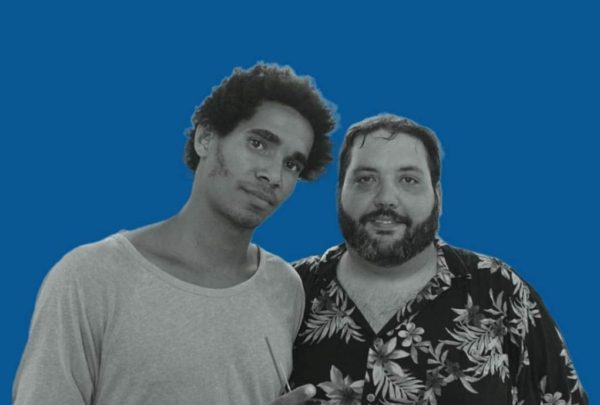
However, Luis was able to reorient that performance very effectively for the point in time in which it occurred. His participation played an important role in showcasing a Cuba where Fidel Castro’s personalism was fading, where economic activities were being decriminalized, and where there was a sense of a certain splendor. Street vending was a new form of business in the tourism industry, and Luis took the opportunity to appear with a slushie cart selling an iconic figure like Mickey Mouse.
What was your impression of his artistic interest? What can you say about his art at that time? Was it as provocative and dissenting as it later became?
Luis’s work always displayed a constant social concern. At that time, it was an interest in what concerned his surroundings, his community, and his locality, which was very complex. It was close to Calzada de Monte and Calzada del Cerro, with marked peculiarities of marginalization, crime, unsafe housing, overcrowded living conditions, in addition to cultural and racial complexity. Like many of his neighbors, he lived in a partially renovated house with a large family. All this social weight would become a breeding ground, a spark for the subsequent development of his work.
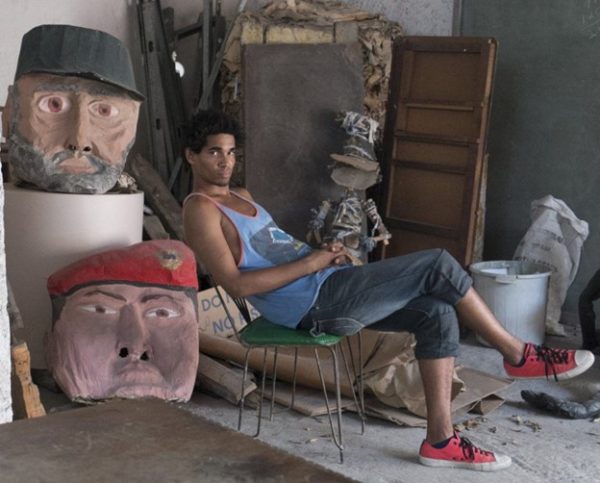
During that time, I remember that Luis always had friends who helped him in his community. Luis is very family-oriented, warm, and affectionate. I think of the presence of a young boy who always accompanied him, having as much fun as Luis in creating the art pieces. He was marginalized in his community, and Luis guided him in actions that took him out of his difficult daily life.
I remember going to Luis’s house; he always had wooden boards and other discarded items that these young men brought to him. They would ask him what he wanted them for, and he would always respond, “I’m going to make an art piece,” and everyone would conspire in the creative process. I also recall one of Luis’s uncles who was heavily involved in the production of these artworks. I watched Luis, and he reminded me of the figure and gesture of Robin Hood because he always had the star quality of a popular leader with a special ability to unite, without arrogance, and without hidden agendas.
Luis’s early works, especially those carved from wood and stone or created using materials like Cellular Lightweight Concrete (CLC), known as “siporex” in Cuba, had a distinct rawness. He crafted faces that conveyed suffering and need, and his use of humble materials added a richness both in terms of form and concept. Luis used raw wood salvaged from demolished or burnt construction materials, often with exposed nails. It presented a poignant image of everyday life and suffering. These pieces themselves spoke and were a part of his early life experiences and understanding.
From a critical perspective, we can’t categorize Luis’s work as Arte Povera, which implies a conscious engagement with material reality. Luis used what was readily available, and reality openly provided it to him. That’s why, to me, Luis will always be an outsider artist.
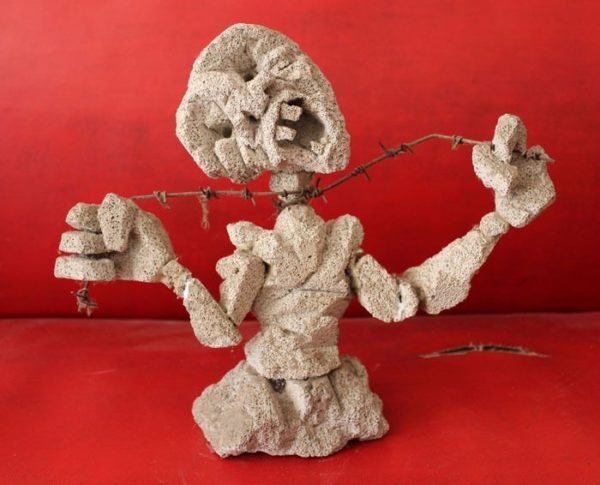
You’ve mentioned Luis Manuel Otero’s community-oriented perspective, and you’ve alluded to the state of community art in Cuba.
I believe that there is very little community art in Cuba, at least not in Havana. To refer to community art, we would have to talk about art created within communities that are an intrinsic part of the cultural heritage of that area. Perhaps in Villa Clara, with the Feijonian Heritage of the Signos group and other artists from Villa Clara. The Bayate Group from Santiago de Cuba, although initiated by a cultural policy, developed a personal and genuinely community-oriented trend.
Luis was not part of any group, nor did he come from a cultural center. He is a genuine spirit linked to a neighborhood with specific characteristics, trapped in a marginalized social context. We could say, from a social and political standpoint, that Luis had all the tools to criticize and validate his work, which exposed all the problems of his community and the “socialist and bourgeois” culture that legitimizes the current Cuban cultural system.
Luis should be an example because he didn’t grow up indebted to favors. He slowly built his art based on what the socialist cultural system demands and from the nature of his own resources. His community understood and supported him. The people who were with him from the very beginning were not intellectuals or enthusiasts; they were members of his own community with the same values and thoughts from which Luis emerged. Is there anything wrong with this? Shouldn’t his way of thinking be an example? How do we position the thoughts of the marginalized and dispossessed? The institution would never be able to answer these questions; more than anything, they were bothered by what Luis represented.
I have my own reservations about the concept of community art because it’s managed differently in the Cuban institution, often involving instruction and cultural centers from the outside. In my view, there are specific actions that an instructor can take, such as facilitating community engagement. However, that doesn’t necessarily make it a part of a community’s cultural heritage. In this case, Luis is an individual who leads a community, a central figure, a true cultural practitioner. He could fit into that terminology, but as Cuba does not follow this methodology or address this movement or any that might emerge autonomously, it remains a complex issue.
Which pieces from his early years impacted you the most? Can you tell us about some of them?
Many pieces from Luis’s early years left a lasting impact on me. Each of them has its own context and particular discourse. I would say all the pieces from the early years, especially the 2011 series dedicated to war amputees, paying tribute to the unsung and forgotten heroes of the Angolan war –a very sensitive work dedicated to those who were mutilated and psychologically scarred. Also, all the Mickey Mouse figures in their different variations.
While there are several paradigmatic pieces, such as the simulation of the Statue of Liberty in New York as a gift from Cuba to the United States in 2015. Another piece that had multiple versions was the “Menina” he exhibited at the Spanish Embassy; a smaller version was exhibited here at Riera Studio, and the larger piece, we didn’t have a place for, so we stored it in the attic of our house.
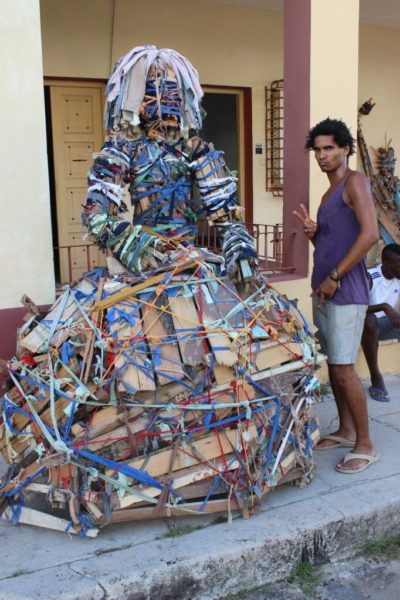
Other pieces were linked to performance actions that were stifled to varying degrees. I’m talking about pieces made from papier-mâché, like the “Virgin of Charity” (2012), “Fidel and Chávez” (2013) during the May Day march, and “San Lázaro” (2019).
“The Elephant” (2012) is another piece with a special appeal. At that time, sculptures of elephants by José Emilio Fuentes (JEFF) were being unveiled at the Trade Center in Miramar, and there was a lot interest in the purchase of this piece. So, Luis created his own elephant and placed it not in Miramar but in a very popular and busy area, an intersection near Monte Street, so that those who couldn’t go to Miramar could see his lucky elephant. Afterward, he placed it at the Capitol.
Luis challenged the sensibilities of the epoch. In 2012, during Pope Benedict XVI’s visit, Luis created the “Virgin of Charity”. Although it was an impressive piece of popular art, it was obviously banned. Before the procession, Luis began a tour, and one block before reaching where the parade would be, State Security agents blocked his way. All over the world, every worshiper who presents themselves before the Pope carries objects, attire, and personal requests. Because the presence of popular art is a highly respected factor in the religious sphere, and in the cultural approach in many countries, it’s not a questioned space. But it is in Cuba. Against all resistance and stagnation, Luis tried, and he was then questioned and prohibited. Luis challenged these setbacks, institutional blindness, and showed how limited the margin of action was within Cuba. But clearly, this also meant greater exposure and frustration for Luis as an artist.
He also created a series of works that were more related to reinterpreting other artists, flirting with the art market. He reinterpreted Goofy, Batman, Superman. This was an exploration of the relationship between art, popular culture, and consumerism.
Luis is an artist with an ambition to explore his personal ego to the maximum. He has an insatiable need for knowledge and a unique potential to draw attention wherever he is, something typical of a leader. Undoubtedly, nothing in his life was going to be half-hearted.
His ability to connect with others took him out of his comfort zone, and he began to insert himself among the most current trends and exhibitions of the time. I can say that within our circle, there was already a desire for change, to take defined actions that involved a new step.
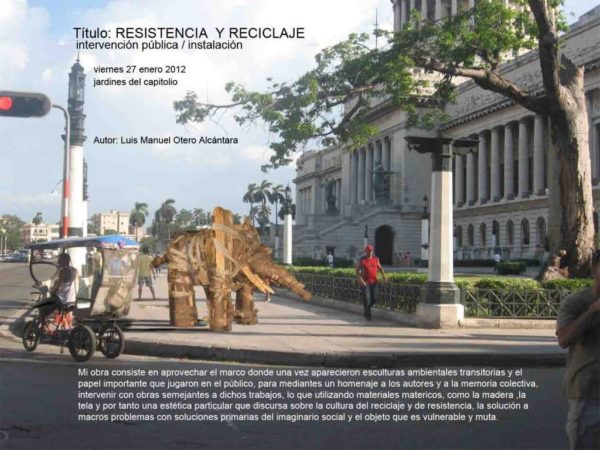
Then, the appearance of Tanya Bernal in Luis’s life introduced ideas that led him to understand his position on a global level. Tanya is an American visual artist, a force that questions reality and advocates for social rights in the United States. At that time, Tanya talked to us about sexual freedom, helped us break free from everyday machismo and heterosexism, and showed us different types of defenses and arguments. Imagine this powerhouse of a woman alongside Luis. Tanya also brought many friends to Havana with whom we had conversations and learned about other realities. Tanya’s arrival set a precedent, allowing Luis to internalize a critical discourse and modulate it with more awareness. They would “workshop” and discuss a lot about the surrounding reality. I would even say it was a controversial bond: two very strong, very talented individuals who often clashed.
It’s worth noting that there were many people who rejected Luis’s way of working. He stood up against this complacency, against any elitist perspective, and he did it by shaking things up, by drawing attention. Luis always has that calling to create, disturb, and disrupt. In this sense, Luis is a consequence of the state in which the nation finds itself, the lack of attention to artists, the rejection by a specific part of society, discrimination, and marginalization. Therefore, he conceived his work to “sneak in,” to disrupt those comfortable spaces. For example, with installations like the Mickey Mouse, he asserted himself, placed clandestine interventions in spaces like La Cabaña, the Grand Theater of Havana, the Superior Art Institute, Carlos III Avenue, and even the Museum of International Art.
In general, if we were to recount the journey Luis Manuel has taken in the art world in these years, it can be said to be a clean journey. Ironically, it’s the journey that should be approved by the Cuban institutional system according to the order they themselves establish: exhibitions accepted and promoted by the Cuban institutional system, starting from municipal galleries to what they call the top level, including the Ludwig Foundation of Cuba, with the involvement of curator Helmo. In the end, wickedly or ironically, everyone denied Luis’s existence as an artist, crucified him, defined him as an intruder, and criminalized him.
Can we say that LMOA always had an inclination for more political or questioning art?
I believe that, in him, there was a general inclination to question first, and then the political aspect, which became more explicit later. Questioning reality was a personal impulse embraced by the weight of a complex social context, and when he couldn’t take it anymore, he delved into the political. We can say that Luis Manuel has abundant realities to directly question those in power because he was never a recipient of social benefits; he is a genuine part of a marginalized society with limited rights. Let’s take, for example, one of his early series, “Los héroes no pesan” (“Heroes are not Heavy”): the images speak for themselves, carrying a strong critique of the revolutionary historical discourse.
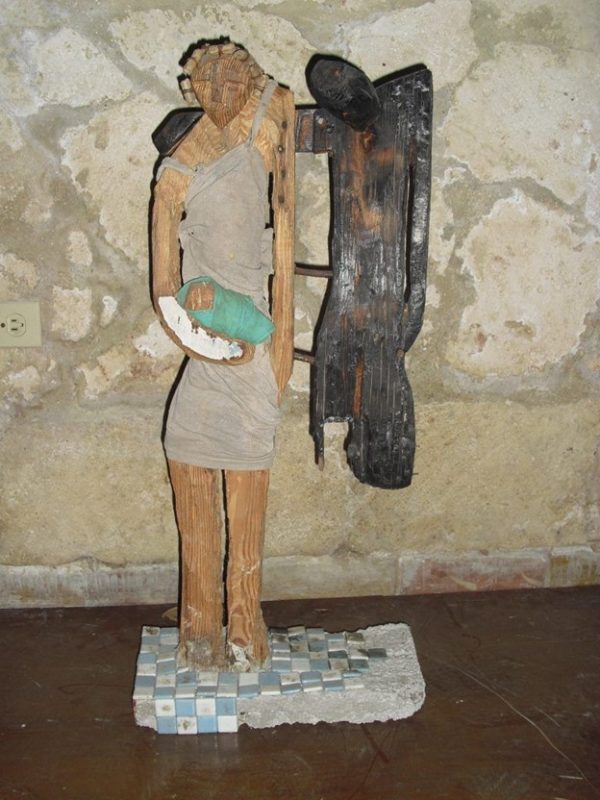
Luis’s work is also the result of the State’s neglect in the face of complex realities with no possibility of change, resulting in social and psychological damage throughout his life. What follows is a consequence of the same reality; as a visionary artist, he constantly clashes with these imposed limits.
For example, when Luis began to reinterpret works, characters, and more, his work took on another dimension. This marked the beginning of his flirtation with contemporary art, as seen in series like “Las arañas” (The Spiders), which is a reinterpretation of the work by the French artist Louise Bourgeois, who had placed monumental bronze spiders on the front of the National Museum of Fine Arts of Havana, the headquarters of Universal Art. Luis’s spiders were smaller, made of wood and tied fabrics, and were later removed by the museum’s own team. So, when Luis challenges the viewer through this contrast, the institution kills his spiders.
Then, I believe his artivist construction leads to a more specific stance. There’s a growth process in his work model; he transitions from a young sculptor to the installation realm, which he later fuses with performance. It’s another evolutionary process within his work, which is essential to understanding the current Luis Manuel.
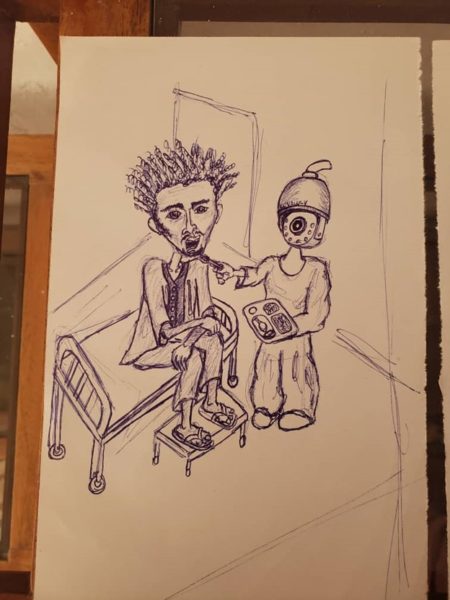
How do you categorize the art that LMOA creates in prison? How do you think his recent experiences have intervened and marked LMOA as an artist?
Certainly, the art he creates in prison will represent another stage in Luis Manuel’s still relatively early life. I believe his life will be an undeniable lesson; in fact, it already is. Luis opened Pandora’s box, and all the ills of national culture spilled out; he shook it, dynamited it, and made everyone look at themselves. While we were wasting time creating art for white-wall galleries, Luis shook those walls and provoked us to do the same.
His work has not been easy, and it has marked his body, soul, and life. If we look at the drawings he made after being confined to the hospital following his hunger strike in 2021, we can see the psychological trauma he endured due to everything he has suffered. The character he created, where he directly addresses the surveillance camera, displays all the tension and vigilance to which he has been subjected, to the point of humanizing the camera to converse with it.
As long as Luis has a piece of paper in his hands, as long as he is aware of his body, no one will stop him: he is an artist in every sense of the word, and an eternal nonconformist. He will always seek to bring forth those ideas, and those ideas will become yet another experience of the cruelty of the times and of prevailing social injustice.
*Translation by Fiona Baler.






Probably the best article about Luis that I’ve ever read. Thank you.